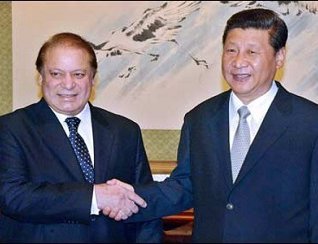
‘This will be my first trip to Pakistan, but I feel as if I am going to visit the home of my own brother’s. In what seemed like a dialogue straight out of a Bollywood movie, this was what Chinese President Xi Jingping said in a flowery op – ed on Pakistan’s Daily Times, just before his maiden visit to the South Asian nation. Xi did not stop there. Replete with slushy phrases, the Chinese President referred to Pakistan as an ‘all weather’ friend and expected his old ally to emerge as an Asian Tiger soon.
While the strategic alliance between Pakistan and China, two countries that share little cultural similarities, is far from ‘brotherly’ in literal sense, one of the objectives of Xi’s visit was to send a message to India and the US. Although China’s trade with India stands four times higher than that with Pakistan, it still maintains strong ties with the latter and does not stop short of flexing muscles at times. As far as the US is concerned, China has outweighed the US support to Pakistan since 2002 by a whopping 15 billion dollar with its recent mega deals.
While friendship between Pakistan and China go a long way, the recent agreements, especially the 46 billion dollar economic corridor should be of worry to India. The ambitious 3,000 km economic corridor connecting the western Chinese city of Kashgar to Pakistan's coastal town of Gwadar will primarily help China increase its access to the Arabian Sea for increasing its trade with Europe, the Middle East and Africa. More importantly, China plans to build oil storage facilities and a refinery at Gwadar Port with oil transported to its Xinjiang region via road and pipeline lying on the corridor. This will mean a much shorter route for China than the one used currently. But what this will also mean is emergence of China as a power player in the Indian Ocean. The arrival of an uninvited guest in its backward is not expected to go down well with India whose defence minister Manohar Parrikar had said only last month that the Indian Navy must remain a superior force in the Indian Ocean Region and that the government was willing to give all support to the Navy in doing so. If the corridor gets built, it would result in a situation of head-on collision between the two countries. There had already been reports that New Delhi is already having headaches with news of Chinese submarines making attempts for ‘port calls’ at Sri Lanka and other Indian Ocean rim countries.
The construction of the corridor would also help increase China’s influence in Pakistan, more importantly in the contentious and vulnerable Pakistan Occupied Kashmir (POK). It is no surprise that China holds huge influence on Pakistan through its military and nuclear support. But the corridor will act as a strong base for China to wield even greater influence. For India, the corridor is also a worry as it passes directly through the PoK, which India claims is illegally occupied. Although unconfirmed, news have emerged saying that China has already laid plans to build an airport near the PoK. Agreement between China and Pakistan to co-operate on natural gas, coal, and solar-energy projects would also pave greater avenues for the emerging superpower to exert power on its close ally. Former chairperson of the India's National Security Advisory Board Shyam Saran’s statement soon after the agreements clearly reflected India’s tensions. The seasoned foreign policy hand expressed the view that India should be upfront in voicing opposition to the corridor and not let the issue pass by easily.
While the corridor does pose great threats for India, it creates an equally big challenge for both China and Pakistan. The connection of Pakistan’s conflict ridden Baluchistan to China’s vulnerable Xingjiang region would make both the areas more prone to separatist as well as jihadi elements. The much-hyped Chinese projects in Pakistan have not produced expected results in the past including the Gwadar port project. The corridor might face the same risk. Both these factors can be of advantage to India. At a time when China is flexing muscles even in the South China Sea by building artificial islands for military purposes, India should be wary of Chinese movements. Modi, who is all set to visit China next month, would keep this in mind and aim to keep China’s influence at a check.
- Ukrainian Crisis And The World (Dis)Order
- Apr 22, 2022
- China’s Cautious Steps In The Graveyard Of Empires
- Aug 18, 2021
- Foreign Aid On The Fence!
- Aug 08, 2021
- Communist Party of China centenary celebrations Reading between the lips
- Jul 14, 2021
- Second Wave Of Covid-19 In India: Deadly Blow To The Economy
- Jun 23, 2021
















